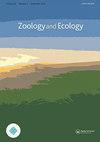Diet of Cataglyphis bicolor (Hymenoptera-Formicidae) in an insular condition in north-eastern Algeria
Q4 Environmental Science
引用次数: 1
Abstract
A study of the adaptation of the ant Cataglyphis bicolor in terms of feeding under insular conditions was conducted on the north-eastern coast of Algeria. For this, three pairs of stations (island-continent) were chosen. Analyzing fragments of prey species found in C. bicolor nests, the diet in each station pair was studied. The results obtained indicate that C. bicolor has an opportunistic diet characterised by insectivory. Indeed, more than 95% of the prey consumed in the six study stations were insects with a clear preference for other ants, with frequencies ranging from 52 to 87%. Among the latter, Messor barbarus, Camponotus sp., Camponotus laurenti, Pheidole pallidula and Tetramorium biskrense were the ants most predated by C. bicolor. The diversity of continental prey seemed greater than that of island environments. For the two Cap Sigli stations, the prey richness was 94 species for the continent against only 28 species for the island environment. For Boulimat, there were 27 prey species for the mainland and 20 prey species for the islet. Finally, for the Sahel region, C. bicolor was able to harvest 42 prey species on the mainland and 28 species on the island. The diversity of C. bicolor prey in the island environments seems to be a function of insect richness (prey availability) and floral richness.阿尔及利亚东北部岛屿条件下的双色盲蝽(膜翅目-蚁科)食性
在阿尔及利亚东北海岸进行了一项研究,研究了蚂蚁在孤岛条件下的摄食适应性。为此,选择了三对站点(岛屿-大陆)。分析了在双色锦鸡巢中发现的猎物种类片段,研究了每对站位对的食性。结果表明,双色瓢虫具有以食虫为特征的机会性食性。事实上,在六个研究站中,超过95%的猎物是对其他蚂蚁有明显偏好的昆虫,频率从52%到87%不等。在后者中,Messor barbarus、Camponotus sp.、Camponotus laurenti、Pheidole pallidula和Tetramorium biskrense是bicolor最早发现的蚂蚁。大陆猎物的多样性似乎比岛屿环境更大。在西格里角的两个站点,大陆环境的猎物丰富度为94种,而岛屿环境的猎物丰富度仅为28种。对于Boulimat,大陆有27种猎物,岛屿有20种猎物。最后,在萨赫勒地区,C. bicolor能够在大陆捕获42种猎物,在岛上捕获28种猎物。岛屿环境中双色瓢虫猎物的多样性似乎是昆虫丰富度(猎物可用性)和植物丰富度的函数。
本文章由计算机程序翻译,如有差异,请以英文原文为准。
求助全文
约1分钟内获得全文
求助全文
来源期刊

Zoology and Ecology
Agricultural and Biological Sciences-Animal Science and Zoology
CiteScore
1.00
自引率
0.00%
发文量
1
 求助内容:
求助内容: 应助结果提醒方式:
应助结果提醒方式:


